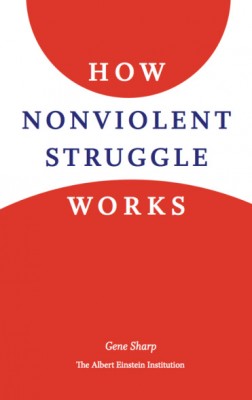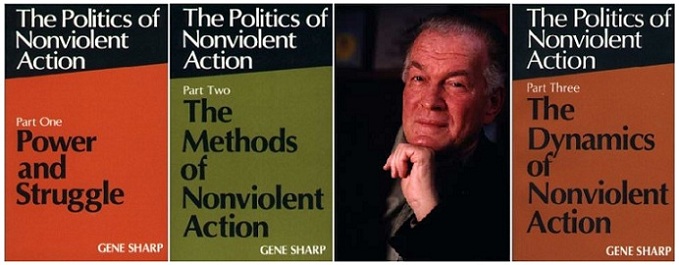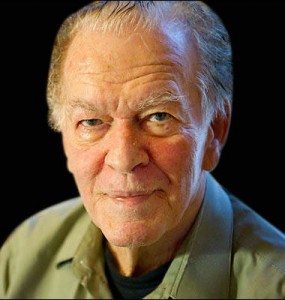Author Archive: Gene Sharp
GENE SHARP (1928-2018) is one of the world’s leading experts on the history, theory, and practice of nonviolence. His three-volume work,
The Politics of Nonviolent Action (Boston: Porter Sargent, 1973) is considered essential reading for anyone interested in any aspect of nonviolence and nonviolent struggle. He is Professor Emeritus of political science at the University of Massachusetts Dartmouth, and was for thirty years a research fellow at Harvard’s Center for International Affairs. He is also founder of the
Albert Einstein Institution in Boston, a non-profit organization concerned with nonviolent action and conflicts.
Additional articles about Gene Sharp are posted here:
by Gene Sharp

Dustwrapper art courtesy aeinstein.org
What nonviolent action is.
Nonviolent action is a technique of sociopolitical action for applying power in a conflict without the use of physical violence. Nonviolent action may involve acts of omission—that is, people may refuse to perform acts that they usually perform, are expected by custom to perform, or are required by law or regulation to perform; acts of commission—that is, people may perform acts that they do not usually perform, are not expected by custom to perform, or are forbidden to perform; or a combination of the two.
As a technique nonviolent action is not passive.
It is not inaction. It is action that is nonviolent.
As a technique, therefore, nonviolent action is not passive. It is not inaction. It is action that is nonviolent. These acts comprise a multitude of specific methods of action or “nonviolent weapons.”
Nearly two hundred have been identified to date, and without doubt, scores more already exist or will emerge in future conflicts. Three broad classes of nonviolent methods exist: nonviolent protest and persuasion, non-cooperation, and nonviolent intervention.
Nonviolent action provides a way to wield power in order to achieve objectives and to sanction opponents without the use of physical violence.
Read the rest of this article »
by Gene Sharp
Editor’s Preface: The manuscript of this unpublished essay is not dated, but based on the dating of other material in the same folder, is c. 1962. It is another in our series of discoveries from the War Resisters’ International archive, which we have been researching for the last year. An archive reference, acknowledgments, and a note about Sharp are at the end. JG
The Indian government and people have responded to the Chinese use of armed force to adjust the border between their countries with war preparations and reliance upon military means to deal with the foreign threat. The Indian reaction has for many people in the peace movement, and pacifists in particular, been something of a shock. Many of these believe that India has somehow let them down, that she has failed to live up to the moral challenge imposed in different ways both by Gandhi and by the nature of modern war.
Read the rest of this article »
by Gene Sharp

Book jacket assemblage courtesy rcnv.org
Editor’s Preface: This little known essay by Gene Sharp was discovered in the War Resisters’ International archive in a folder labeled “Ira Sandperl’s Speaking Tour of Western Europe, 1970: Background Reading.” The typescript seems to have been given to Sandperl by Sharp. We have not found any evidence that Sharp published the essay in this form, although he was to rework the material in later works, especially the section below “84 Cases of Nonviolent Action”. Sandperl was an interesting figure in the 1970s peace movement. A foremost member of the War Resisters League, (the U.S. branch of WRI), he might be better known to some as Joan Baez’s acknowledged mentor. Sandperl was also co-founder of the Peninsula Peace Center in California, which Baez also helped support. Please see the notes at the end for further information about Gene Sharp, archival references, and acknowledgments. JG
It is widely believed that military combat is the only effective means of struggle in a wide variety of situations of acute conflict. However, there is another whole approach to the waging of social and political conflict. Any proposed substitute for war in the defense of freedom must involve wielding power, confronting and engaging an invader’s military might, and waging effective combat. The technique of nonviolent action, although relatively ignored and undeveloped, may be able to meet these requirements, and provide the basis for a defense policy.
Read the rest of this article »
by Metta Spencer

Book jacket courtesy Oxford University Press; global.oup.com
Metta Spencer: It has been eight years since I last interviewed you for the magazine. Since then people around the world have begun to listen to you.
Gene Sharp: Yes, I was just now invited to a Washington journal — Foreign Policy — who will publish something about people who had some response in the world in the last year. That kind of invitation never happened a few years ago.
Spencer: I know. In fact, let’s begin by reviewing the changes in your own thinking. As I recall, you started off as a graduate student in sociology working on a masters thesis and have managed to turn into Gene Sharp, the guy on the front page of the New York Times. Let’s start at the time when you began to realize that nonviolence was a special set of practices that could be developed into useful procedures.
Sharp: Ah yes! One thing that was in the master’s thesis was a typology of nonviolence. I classified six or seven belief systems, of which one was called “nonviolent resistance.” That’s a different category but it was in with the others. (Today I don’t even like the term “nonviolence” except for very special uses.) That typology went through several revisions and one was published in the Journal of Conflict Resolution, which was an entirely new publication at the time. In it I took out nonviolent struggle as a separate category. That was a breakthrough in my thinking — that people didn’t have to have the belief in order for them to act.
I remember one time in the basement of the Ohio State University library. I was looking through old Indian newspapers on the conflict — I think it was the 1930 campaign — and the evidence was there: These people did not believe in nonviolence as an ethic! That was a shock. I thought: Oh dear! We didn’t have copy machines then. I had to copy the whole thing by hand and I thought; should I copy that down? It’s not supposed to be that way. But my focus on reality won out, fortunately, and I copied it down. Later I realized that it wasn’t a problem. It was a breakthrough, an opening! People didn’t have to believe in order to use this form of action! Therefore, it was open to almost everybody. That breakthrough was in about 1950 or ’51.
Read the rest of this article »
by Amitabh Pal

Gene Sharp, 2012; photographer unknown; courtesy of tarata21.com
Gene Sharp is perhaps the most influential proponent of nonviolent action alive. His work has served as a how-to manual for activists in a swath of countries across Eastern Europe and Asia. For instance, From Dictatorship to Democracy and The Politics of Nonviolent Action helped inspire the Serbian student movement that toppled Slobodan Milosevic in 2000.
Sharp writes, “Nonviolent action is possible, and is capable of wielding great power even against ruthless rulers and military regimes, because it attacks the most vulnerable characteristic of all hierarchical institutions and governments: dependence on the governed.”
Sharp drafted From Dictatorship to Democracy at the invitation of a Burmese activist. He was smuggled into Burma to assist in courses on nonviolent struggle for those resisting the military regime. He was in Tiananmen Square shortly before the tanks started rolling in. He has traveled to Israel and Palestine a number of times to disseminate his ideas. He was also invited into Latvia, Lithuania, and Estonia, this time by the governments themselves. He consulted with ministers on the nature and requirements of the campaign that they were using to peacefully secede from the Soviet Union. The three governments also used as a guide his book Civilian-Based Defense. The three countries became sovereign with almost no loss of life.
Read the rest of this article »
by Gene Sharp
Violence in society and politics, whether in the form of war, terrorism, dictatorship, oppression, usurpation, or genocide, is widely recognized as a grave problem.
All the proposals to solve the problem of violence, or particular expressions of it, have been unsuccessful. It is probable that the problem remains unsolved because such proposals have been based on inadequate understandings of its nature. Without understanding a problem, it is difficult, if not impossible, to solve it.
The objective of this essay is to explore a different perspective on the nature of the problem of widespread violence in society and politics that suggests what will be required for its resolution.
Read the rest of this article »
by Gene Sharp
THE METHODS OF NONVIOLENT PROTEST AND PERSUASION
Formal Statements
1. Public Speeches
2. Letters of opposition or support
3. Declarations by organizations and institutions
4. Signed public statements
5. Declarations of indictment and intention
6. Group or mass petitions
Read the rest of this article »








